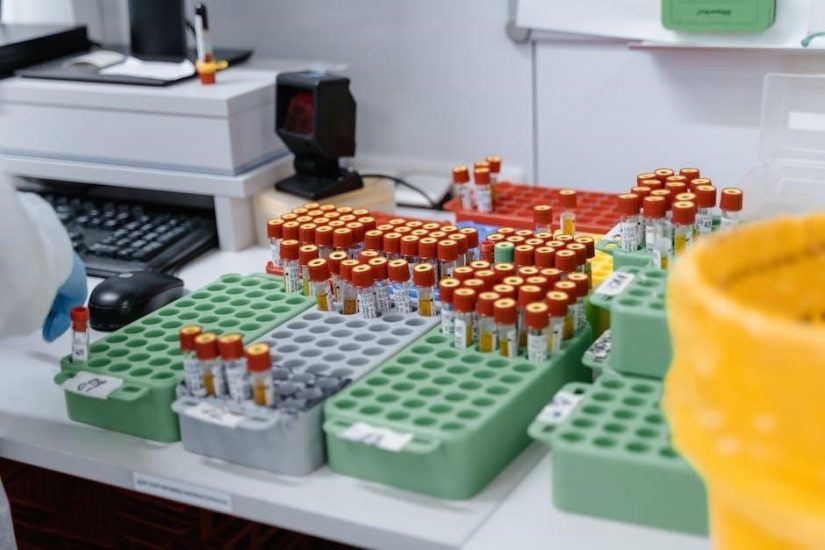Microbiology Laboratory Theory & Application PDF: A Comprehensive Guide
This comprehensive guide serves as a valuable resource for understanding microbiology laboratory theory and application. It covers essential techniques, safety protocols, and diagnostic procedures. This manual is designed for students and professionals.
Embarking on the journey into microbiology laboratory practices requires a foundational understanding of core principles. This introduction sets the stage for hands-on experiments, emphasizing the importance of aseptic techniques to prevent contamination. Essential equipment, such as microscopes and autoclaves, are introduced, along with their proper usage and maintenance. Safety protocols are paramount, ensuring a secure learning environment.
Understanding the nature of microorganisms, including bacteria, fungi, and viruses, is crucial. This introduction highlights the significance of accurate observation and data recording. Moreover, it emphasizes the role of microbiology in various fields, from medicine to environmental science. Mastering these basic practices is essential for successful laboratory work and future studies in microbiology. This section provides a solid base for advanced techniques, fostering a scientific mindset.
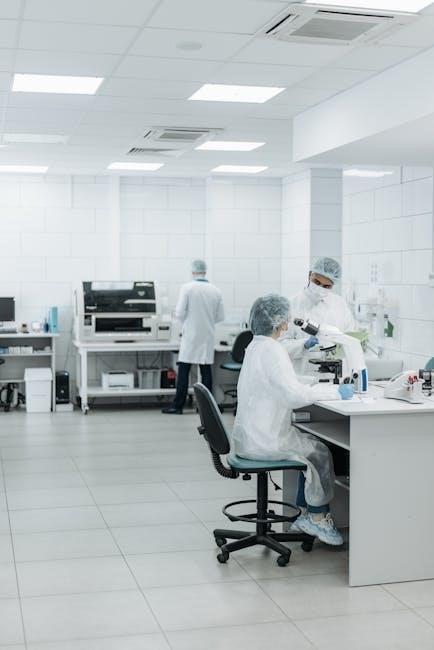
Basic Laboratory Techniques
Mastering fundamental laboratory techniques is crucial in microbiology. These techniques, including accurate measurements and aseptic handling, form the groundwork for reliable experimentation and analysis. Proficiency in these areas ensures valid and reproducible results.
Sterilization and Disinfection Methods
Sterilization and disinfection are paramount in microbiology, preventing contamination and ensuring accurate results. Sterilization eliminates all microorganisms, while disinfection reduces their number to a safe level. Common sterilization methods include autoclaving, which uses high-pressure steam, and dry heat sterilization, suitable for heat-stable materials. Filtration, employing filters with small pore sizes, removes microorganisms from liquids.
Disinfection methods include chemical disinfectants like bleach, alcohol, and quaternary ammonium compounds. These chemicals target different microbial components, disrupting their function or structure. UV radiation is another disinfection method, damaging microbial DNA and inhibiting replication. Choosing the appropriate method depends on the material being treated and the desired level of microbial control.
Understanding the mechanisms and applications of these methods is crucial for maintaining a sterile laboratory environment and preventing the spread of infection. Proper implementation of sterilization and disinfection protocols is essential for reliable experimental outcomes and safety in microbiological research and practice. This knowledge is fundamental for anyone working in a microbiology laboratory.
Microscopy and Staining Procedures
Microscopy and staining procedures are fundamental techniques in microbiology, enabling the visualization and characterization of microorganisms. Microscopy utilizes lenses to magnify tiny organisms, revealing their morphology and structural details. Different types of microscopes exist, including light microscopes, which use visible light, and electron microscopes, which employ electron beams for higher resolution imaging.
Staining procedures enhance contrast, making microorganisms more visible under the microscope. Simple stains use a single dye to color the cells uniformly, while differential stains, like Gram staining, differentiate bacteria based on their cell wall composition. Gram staining distinguishes between Gram-positive and Gram-negative bacteria, aiding in identification.
Acid-fast staining is used for bacteria with waxy cell walls, such as Mycobacterium. Special stains highlight specific structures, like endospores or capsules. Proper staining techniques are essential for accurate microscopic observation and identification of microorganisms. Mastering microscopy and staining procedures is crucial for anyone studying microbiology, enabling them to visualize the microbial world and understand its diversity.
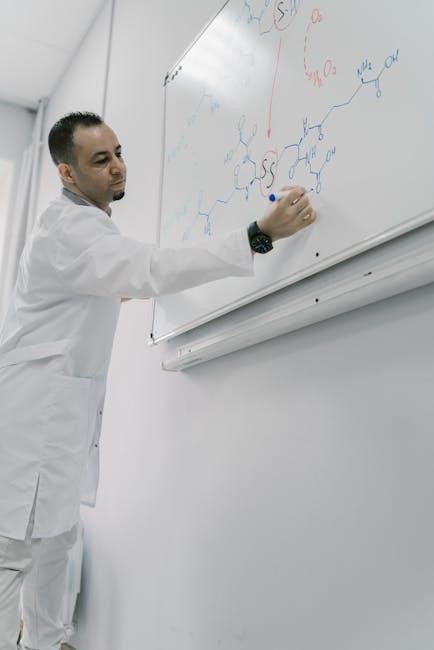
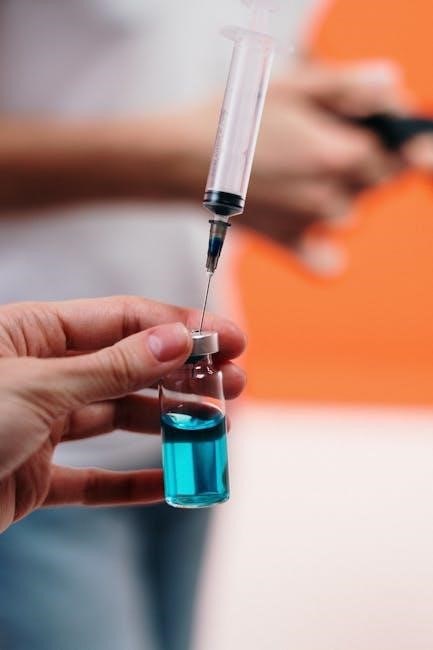
Culture Media Preparation
Culture media preparation is a cornerstone of microbiology, providing the necessary nutrients for microorganisms to grow in a controlled laboratory setting. Culture media can be liquid (broth) or solid (agar-based), depending on the application. Preparing culture media involves dissolving specific ingredients in water, adjusting the pH, and sterilizing the mixture to eliminate any contaminating microorganisms.
Different types of media exist, including nutrient broth, which supports the growth of a wide range of bacteria, and selective media, which inhibit the growth of certain microorganisms while allowing others to thrive. Differential media contain indicators that allow for the visual differentiation of microorganisms based on their metabolic activities.
Accurate measurement of ingredients, proper mixing, and appropriate sterilization techniques are crucial for ensuring the quality and reliability of culture media. Autoclaving is commonly used for sterilization, employing high temperature and pressure to kill all microorganisms. Prepared culture media must be stored properly to prevent contamination and maintain its effectiveness. Mastering culture media preparation is essential for cultivating and studying microorganisms in the laboratory.
Pure Culture Techniques (Streak, Spread, and Pour Plate Methods)
Obtaining pure cultures is fundamental in microbiology for studying individual microbial species. Three common techniques are employed: streak plate, spread plate, and pour plate methods. The streak plate method involves diluting a mixed culture by streaking it across the surface of an agar plate, creating isolated colonies. The spread plate method involves diluting a sample and spreading a known volume onto an agar plate, resulting in evenly distributed colonies;
The pour plate method involves diluting a sample and mixing it with molten agar before pouring it into a petri dish, resulting in colonies growing both on the surface and within the agar. Each method aims to isolate individual cells that will grow into distinct, genetically identical colonies.
Proper aseptic technique is crucial to prevent contamination during these procedures. Selecting the appropriate method depends on the initial concentration of microorganisms and the desired outcome. Pure cultures are essential for accurate identification, characterization, and downstream applications in microbiology research and diagnostics. These techniques are essential for any microbiology laboratory.
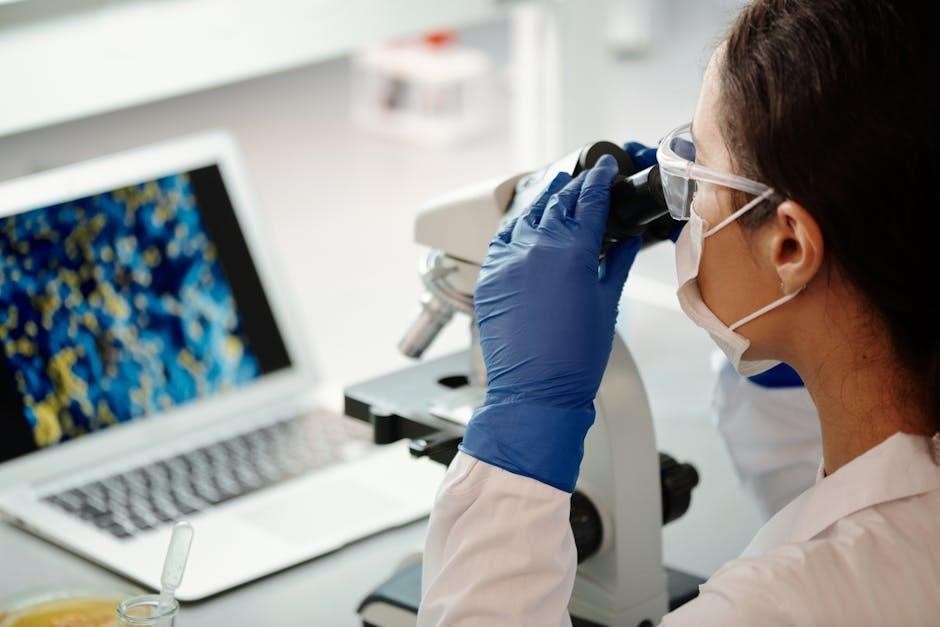
Microbial Identification
Microbial identification is crucial in microbiology for various applications. It involves employing several techniques to characterize and classify microorganisms. These techniques include morphological, biochemical, and genetic analyses, aiding in understanding microbial roles.
Biochemical Tests for Bacterial Identification
Biochemical tests are fundamental tools in microbiology laboratories for bacterial identification. These tests assess a bacterium’s ability to perform specific biochemical reactions, providing a metabolic “fingerprint;” Common tests include catalase, oxidase, and various sugar fermentation assays. The results help differentiate bacterial species based on their unique enzymatic capabilities and metabolic pathways.
For instance, the catalase test detects the presence of catalase, an enzyme that breaks down hydrogen peroxide into water and oxygen. Sugar fermentation tests assess a bacterium’s ability to ferment specific sugars, producing acid or gas as byproducts, which are indicated by color changes in the media. Oxidase tests identify bacteria that produce cytochrome c oxidase, an enzyme involved in the electron transport chain.
These tests are typically performed using standardized protocols and media, ensuring reliable and reproducible results. By combining the results of multiple biochemical tests, microbiologists can create a profile to accurately identify bacterial isolates. This process is essential for diagnosing infectious diseases, monitoring food safety, and conducting environmental studies.
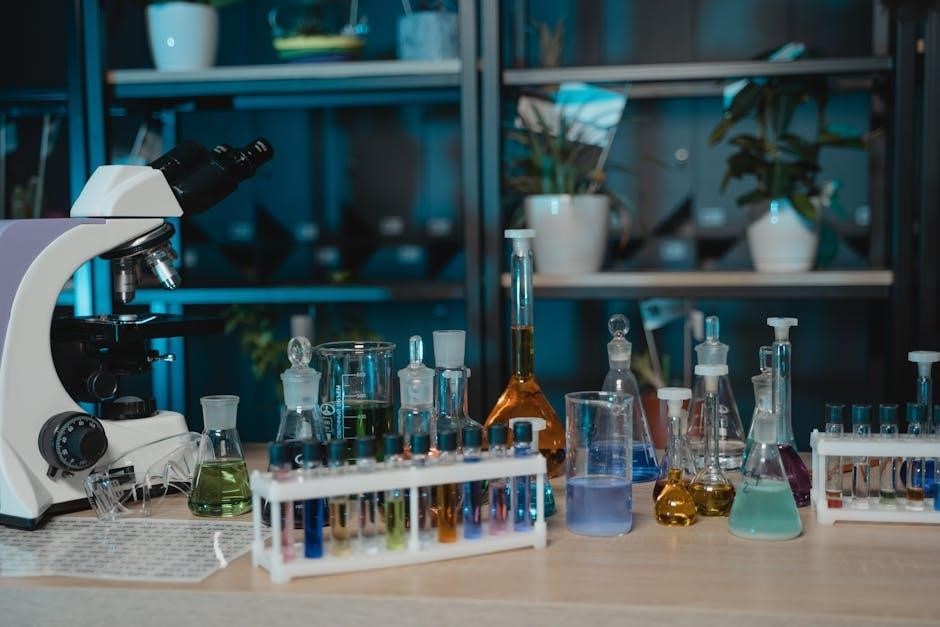
Using Manual of Clinical Microbiology
The “Manual of Clinical Microbiology” (MCM) serves as an indispensable resource in clinical microbiology laboratories. This comprehensive manual offers detailed protocols and guidelines for identifying microorganisms, performing antimicrobial susceptibility testing, and ensuring quality control. It is regularly updated to reflect the latest advancements and best practices in the field.
The MCM provides detailed descriptions of various microorganisms, including their characteristics, clinical significance, and identification methods. It also includes comprehensive information on laboratory safety, specimen collection and handling, and data interpretation. This ensures accuracy and reliability in diagnostic testing.
Laboratories use the MCM to standardize their procedures and maintain consistency in their results. It assists microbiologists in selecting appropriate tests, interpreting results accurately, and reporting findings effectively. This manual is a vital tool for both experienced professionals and trainees in clinical microbiology, fostering improved patient care through accurate and timely diagnoses. It helps guide clinical decisions and treatment strategies.

Safety and Quality Control
Maintaining stringent safety protocols and quality control measures is paramount in a microbiology laboratory. These practices ensure accurate results, protect personnel, and prevent contamination, thereby safeguarding the integrity of diagnostic and research activities.
Laboratory Safety Precautions and Guidelines
Adhering to strict laboratory safety precautions and guidelines is critical in any microbiology setting. These measures minimize the risk of exposure to potentially hazardous microorganisms and ensure a safe working environment. Personal Protective Equipment (PPE), including gloves, lab coats, and eye protection, must always be worn. Proper handwashing techniques should be practiced before and after experiments, as well as after removing gloves.
Work surfaces must be regularly disinfected with appropriate solutions to prevent contamination. All cultures and biological waste should be handled as potentially infectious and disposed of according to established protocols, typically involving autoclaving or incineration. Spills of biological materials must be cleaned up immediately, using appropriate disinfectants and following spill response procedures.
Furthermore, it’s essential to receive thorough training on the specific hazards associated with the microorganisms being handled and to be familiar with emergency procedures. Following these guidelines protects personnel and ensures the integrity of experiments.

Quality Control in the Microbiology Laboratory
Maintaining rigorous quality control (QC) is paramount in a microbiology laboratory to ensure accurate and reliable results. QC procedures encompass all aspects of laboratory operations, from media preparation to equipment maintenance. Regularly testing culture media for sterility and performance is crucial. This involves using known organisms to verify that media supports expected growth characteristics.
Equipment such as autoclaves, microscopes, and incubators must undergo routine maintenance and calibration. Temperatures, pressures, and timing cycles need to be monitored and documented. Stock cultures used for identification should be authenticated and stored properly to prevent contamination or loss of viability.
Proficiency testing, where the laboratory analyzes unknown samples and compares results with reference laboratories, is essential for assessing overall performance. Adherence to standard operating procedures (SOPs) and participation in external quality assurance programs further enhance the reliability and accuracy of laboratory findings, ultimately impacting patient care and research outcomes. Documentation of all QC activities is a must.
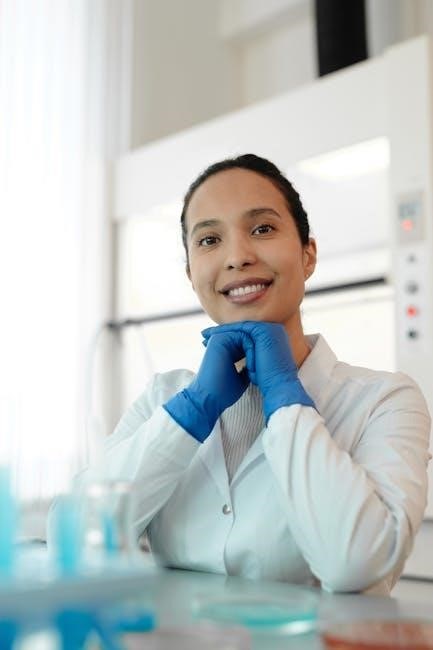
Applications of Microbiology
Microbiology extends into diverse fields, impacting pharmaceuticals, clinical diagnostics, and environmental science. Its applications range from developing novel antibiotics to identifying infectious agents and monitoring water quality, highlighting its significance.
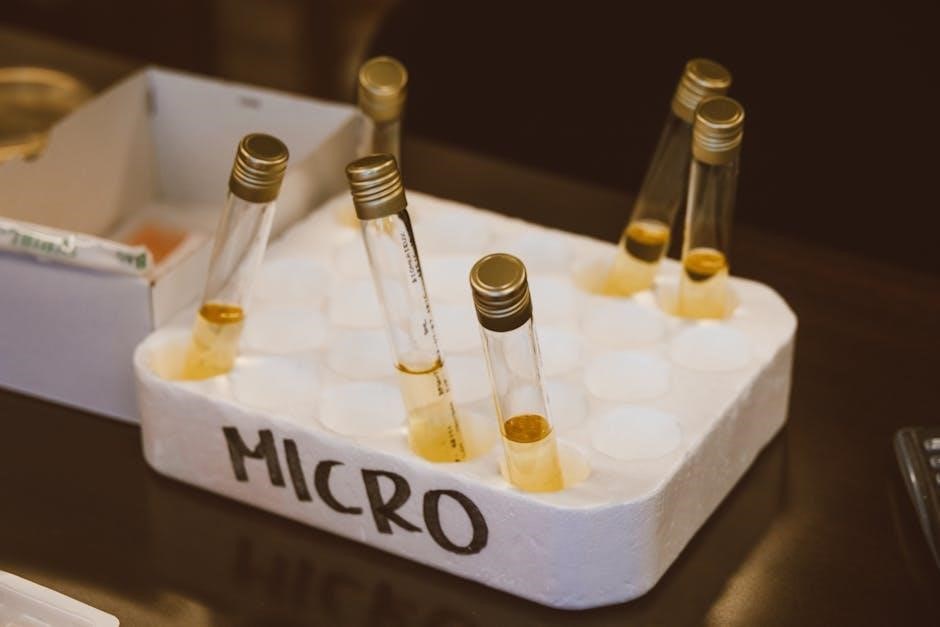
Microbiology in Pharmaceutical Applications
Microbiology plays a crucial role in pharmaceutical applications, encompassing drug discovery, production, and quality control. Microorganisms are harnessed to produce antibiotics, vaccines, and other therapeutic agents. Fermentation processes, a cornerstone of industrial microbiology, are employed to synthesize various pharmaceuticals. Rigorous quality control measures, including sterility testing and microbial identification, are essential to ensure the safety and efficacy of pharmaceutical products.
The development of novel antimicrobial agents relies heavily on microbiological research, particularly in the face of increasing antibiotic resistance. Understanding microbial pathogenesis and resistance mechanisms is paramount in designing effective drugs. Furthermore, microbiology contributes to the development of diagnostic tools for identifying and monitoring infectious diseases, enabling timely and appropriate treatment.
Pharmaceutical microbiology also involves the study of microbial contamination in pharmaceutical products and manufacturing environments. Proper sterilization and disinfection techniques are vital to prevent contamination and maintain product integrity. The application of microbiological principles is indispensable in upholding the quality and safety standards of the pharmaceutical industry.
Microbiology in Clinical Diagnostics
Clinical diagnostics heavily relies on microbiology for the identification and characterization of infectious agents. Microbiological tests are essential for diagnosing bacterial, viral, fungal, and parasitic infections. These tests involve culturing specimens, staining techniques, and biochemical assays to identify pathogens. Rapid diagnostic methods, such as PCR, enable quick and accurate detection of infectious agents, aiding in timely treatment decisions.
Antimicrobial susceptibility testing is crucial for determining the effectiveness of antibiotics against specific bacterial strains. This information guides clinicians in selecting appropriate antimicrobial therapies. Molecular diagnostic techniques, including DNA sequencing, provide valuable insights into microbial genetics and resistance mechanisms.
Clinical microbiology laboratories play a vital role in monitoring and controlling infectious diseases. They conduct surveillance studies to track the emergence and spread of antibiotic-resistant organisms. The accurate and reliable performance of microbiological tests is paramount in ensuring patient safety and effective disease management. Clinical microbiologists work closely with physicians and other healthcare professionals to provide essential diagnostic information.
